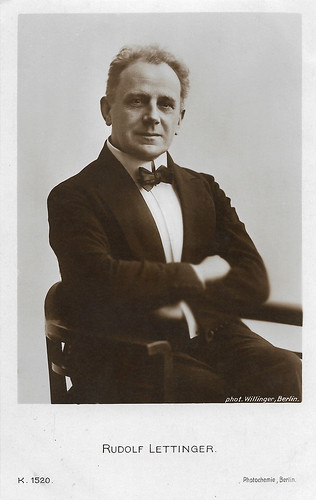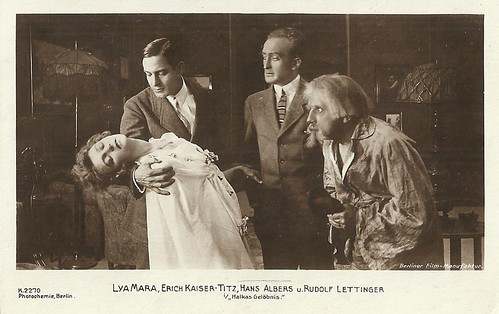
German postcard by Photochemie, Berlin, no. K.1520. Photo: Willinger, Berlin.

Spanish collectors card by Chocolat Imperiale, Barcelona, Day 7, no. 8 in a series of 8 cromos. Photo: J. Gurgui, Barcelona / May Film. Mia May and Rudolf Lettinger as Detective Hunt in the serial Die Herrin der Welt/The Mistress of the World (Joe May, 1919). Spanish film title: La dueñá del mundo.

German postcard by Ed. Verlag des evangelischen Bundes, Berlin, 1933. Printed by O. Felsing, Berlin. Photo: Cob Film. Rudolf Lettinger and Elsa Wagner as Martin Luther's parents after the loss of a child, in the German silent film Luther (Hans Kyser, 1928), starring Eugen Klöpfer as Luther.
Cyrano von Bergerac
Rudolf Lettinger was born in 1865 in Hamburg. At his father's request, Lettinger underwent an apprenticeship in a commercial business after finishing school before deciding on a career as an actor.
In 1883 he made his debut as Kosinsky in Friedrich Schiller's 'Robbers' in Eckernförde in Schleswig-Holstein. He then moved to the theatre in Detmold for a year, then to Heidelberg, and for three years to Stettin in the role of a youthful hero and lover.
Further theatre stations were Magdeburg (1890), Nuremberg (1891/92), and Zurich (1893), before he made the switch to the character field with a multi-year engagement at the Hoftheater Oldenburg. From 1897 to 1901 he appeared in Breslau and came to Berlin to the Schillertheater in 1901. He worked several times under the direction of Max Reinhardt. His portrayals of Gessler in 'Wilhelm Tell as well as his Cyrano in 'Cyrano von Bergerac' were particularly praised.
In 1912 Lettinger joined the silent film industry where he appeared busily in a wide variety of roles as a comic old man. From 1915 his career really set off with parts in films by Emmerich Hanus, Paul von Woringen and others at Berliner Film-Manufaktur such as Halkas Gelöbnis/Halka's pledge (Paul von Woringen, 1918) with Lya Mara.
From 1917 he also acted at Messter, Luna, May-Film, Lotte Neumann-Film and Ring-Film, e.g. in Erträumtes/Dreamed up (Adolf Gärtner, 1918) with Eva May. He acted opposite Lotte Neumann in Die Ehe der Charlotte von Brakel/The Marriage of Charlotte von Brakel (Paul Von Woringen, 1918) and Das Schicksal der Carola van Geldern/The Fate of Carola van Geldern (Carl Froelich, 1919).

German postcard by Rotophot in the Film-Sterne series, no. 564/1. Photo: Ring Film. Eva May in Erträumtes (Adolf Gärtner, 1918). In this film, May plays an actress who renounces her love for an heir to the throne, played by Ernst Pröckl. This card shows Eva May as the actress Geraldine, while the man may well be Rudolf Lettinger, who plays the husband of a friend. The producer was Erik Lund, who afterwards would direct many films with May. Note how May looks older than in her subsequent roles of the early 1920s.

German postcard by Rotophot in the Film-Sterne series, no. 564/2. Photo: Ring-Film. Left to right: the actress Geraldine (Eva May), in the chair: her beloved, the gravely ill crown prince (Ernst Pröckl), behind him his parents, the prince and princess (Leopold von Ledebur and Olga Engl), and right, the husband of the girlfriend (Rudolf Lettinger), in Erträumtes (Adolf Gärtner, 1918). The story deals with an actress who renounces her love for the heir to the throne.

German postcard by Photochemie, no. K. 2165. Photo: Lotte Neumann-Film, Berlin. Lotte Neumann in Die Ehe der Charlotte von Brakel/The Marriage of Charlotte von Brakel (Paul von Woringen, 1918). Her co-stars were Bruno Kastner and Frida Richard. The man behind Neumann is Rudolf Lettinger.

German postcard by Photochemie, no. K. 2167. Photo: Lotte Neumann-Film, Berlin. Lotte Neumann in Die Ehe der Charlotte von Brakel/The Marriage of Charlotte von Brakel (Paul von Woringen, 1918). Her co-stars were Bruno Kastner and Frida Richard (left). The man collapsing is Rudolf Lettinger.
Das Cabinet des Dr. Caligari
Rudolf Lettinger acted in two of Fritz Lang's films, Harakiri (1919) with Lil Dagover and the adventure serial Die Spinnen/The Spiders (1920), and he was detective Hunt in Joe May's Die Herrin der Welt (part 8): Die Rache der Maud Fergusson/Mistress of the World (1920). But his most famous film was the classic Das Cabinet des Dr. Caligari/The Cabinet of Dr. Caligari (Robert Wiene, 1920), in which Lettinger took on the role of Dr. Olsen.
All through the 1920s, Lettinger was most active in supporting parts in major titles such as Nathan der Weise/Nathan the Wise (Manfred Noa, 1922) with Werner Krauss, Tragödie der Liebe/Tragedy of Love (Joe May, 1923) with Mia May, Gehetzte Menschen/Hunted Men (Erich Schönfelder, 1924) with Lucy Doraine.
Other films were Der Mann auf dem Kometen/The Man on the Comet (Alfred Halm, 1925) with Luciano Albertini, Bismarck, 1. Teil/Bismarck (Ernst Wendt, 1925), Die Gesunkenen/The Fallen (Rudolf Walther-Fein, Rudolf Dworsky, 1926) with Asta Nielsen, and the historical romance Zopf und Schwert - Eine tolle Prinzessin/Sword and Shield (Victor Janson, Rudolf Dworsky, 1926) with Mady Christians.
Among his last silent films were Der Katzensteg/The Catwalk (Gerhard Lamprecht, 1927) with Jack Trevor, Luther (Hans Kyser, 1928) with Eugen Klöpfer, plus many lesser-known titles. From 1930 he acted in six early sound films. His last known film participation was in the adventure film Emil und die Detektive/Emil and the Detectives (Gerhard Lamprecht, 1931), based on the 1929 novel by Erich Kästner, who also contributed to the film's script. He was (past) 65 then.
Rudolf Lettinger was married to the actress Marie Wendt and he died in 1937 in Berlin-Schöneberg in Nazi-Germany. He was 71.

German postcard by Photochemie, Berlin, no. K. 2270. Photo: Berliner Film-Manufaktur. Lya Mara, Erich Kaiser-Totz, Hans Albers and Rudolf Lettinger in the German silent film Halkas Gelöbnis/Halka's Vow (H. Fredall, 1918). This postcard is one of a set of three cards that Photochemie issued on the film.

German postcard by Photochemie, Berlin, no. K. 2273. Photo: Berliner Film-Manufaktur. Rudolf Lettinger and Lya Mara in Halkas Gelöbnis/Halka's Vow (H. Fredall a.k.a. Alfred Halm, 1918). This is one of a set of three cards that Photochemie issued on the film. Alfred Halm directed the film under his regular pseudonym H. Fredall, while he also scripted the film.

German postcard by Ross Verlag, no. 45/6. Photo: Bismarck-Film. Franz Ludwig as Otto von Bismarck, Erna Morena as Johana von Puttkamer, Rudolf Lettinger and Maria Santen in the German biopic Bismarck, Teil. 1 (Ernst Wendt, 1925). Caption: Bismarck's betrothal to Johanna von Puttkamer.

German postcard by Photochemie, Berlin, no. K. 1519. Photo: Willinger, Berlin.
Sources: Wikipedia (German and English) and IMDb.
This post was last updated on 19 March 2025.
No comments:
Post a Comment